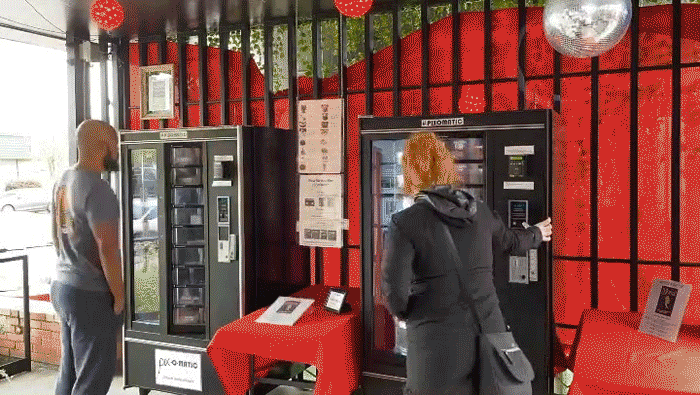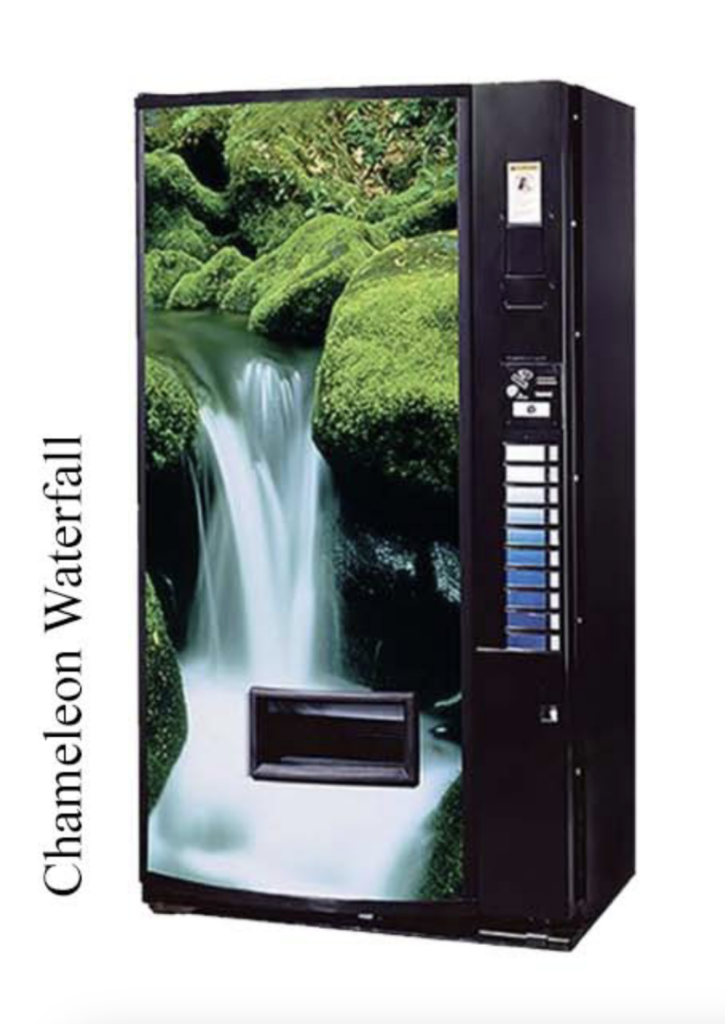Lately I’ve been spending time on Vending Machine TikTok. It’s a soothing, optimistic place where small-business owners rule the land and glinting, aluminum-packaged cheese snacks are omnipresent. In the videos, which regularly rack up millions of views, vending machine owners unlock their machines and count up their dollars, coins, and card-reader funds, tallying everything to a grand total and giving us a peek behind the clear glass curtain.
The amounts of money earned in the TikToks are vastly different: sometimes $4 in four days, sometimes $288.76 in 20 days. Sometimes operators don’t check the machine for a while and unnoticed malfunctions lead to months of disuse. Even though I am 31—which is 85 in TikTok years—I got a little obsessed with VendTok. Watching the videos feels like picking up the pieces of a puzzle I didn’t even realize I wanted to solve: What makes a good vending machine? What, in fact, is the ideal vending machine?
It depends on who you ask. I think the ideal vending machine is probably this lithographed 19th-century German number, or maybe this Windows screen saver beauty—both seem frankly more creative than today’s typical black–and–gray models, but that’s just me. To get the real answer, I knew I had to talk to experts.
Jim Chico told me he lives, eats, drinks, and sleeps vending. Jim is the VP of global sales at U-Select-It, a 92-year-old vending machine manufacturer whose first machine was a penny peanut dispenser that, on every ninth vend, rang a bell and spit out a free roasted peanut. This is the kind of old-school, tactile shit that I love.

ThePix-O-Matic in Portland, Oregon
Let me back up slightly. I’ve never taken an economics class. I don’t like thinking about numbers. That’s not the side of the business that interests me. What interests me is the fact that I can put a dollar into a box and a miniature Rube Goldberg machine sends me a snack. Call me a grandpa or a hamster, but I think that’s cool. Modern and ubiquitous and yet centuries old, vending machines have the same appeal, to me, as a carnival game—except you always win .
There are more than 17,000 vending machine operators in the United States, over 67 percent of which are small businesses. Operators that earn more than $10 million annually make up less than 10 percent of the industry.
Chico got started in the business in college, when he put a cigarette vending machine in a friend’s bar. In the interest of public health, cigarette machines were banned in the ’90s, but this was a minor loss in the grand scheme of things. “In the 35 years I’ve been involved, [the business has] never been stagnant,” said Tom De Paola, director of sales at Dependable Break Room Solutions, a company that services over 1,400 vending machines around Los Angeles. New technology hasn’t replaced vending machines but rather reinforced their value. “You can monitor everything,” said De Paola, in reference to sensors that function like the ones in a hotel mini fridge. The immediate awareness of what’s selling leads to more precise business practices. “You used to take out a full truck of product, go hit your machines, and come back with half a truck of product. Today you take out a full truck of product and you come back with nothing. Efficiency has gone through the roof.”
One of the first vending machines was a device in Roman Egyptian temples that dispensed holy water for worshippers to bathe in before services. Modern machines take Apple Pay, and some of them dispense seltzer (the holy water of today). Vending has seeped into every line of business, from baked goods to tinned seafood to fresh cuts of meat.
Vending machines have the same appeal as a carnival game—except you always win.
I asked De Paola: Which is the best snack, the one that always sells out? It was quickly explained to me that selling out is bad—it means you just lost money. Normally, when it comes to items like concert tickets or Sandy Liang drops, selling out is good. But in the world of convenience, customer service is way more important than hype. If a snack is selling out, you add another column to meet the need. When it comes to the best-selling (though hopefully not selling-out) snacks, the answer is simple: Snickers bars and M&M’s. Although the industry has been in flux since the ’70s, this hasn’t changed. Somehow this bolsters my faith in society. “Six or eight of the top ten [snacks] have been the same for the last four decades. Y’know, Snickers bars and peanut M&M’s,” said Chico.
Cheryl Wakerhauser had to install a whole second machine when her first kept emptying out by morning. Wakerhauser runs the Pix-O-Matic, a one-of-a-kind dessert vending machine in Portland, Oregon. In the spirit of Keeping Portland Weird, the city’s residents have opened a whole slew of curated machines, selling everything from oracle readings to VHS tapes to vibrators. Wakerhauser bought her first machine during the COVID-19 pandemic, when the brick-and-mortar version of her long-running bakery, Pix Patisserie, closed down. Although the bakery’s overall revenue dropped by 25 percent, profits more than doubled, thanks to lower labor costs and longer business hours.
The two refrigerated Pix-O-Matics are stocked daily with seasonal desserts like Oregon pear tarts and s’mores-flavored macarons, as well as sourdough starters, creamy French cheeses, and PEZ dispensers. There are even some nonedible items, including a genius two-for-one combo: “French beret with pocket flask. As you can imagine, the combo sells well in the middle of the night,” said Wakerhauser.
The model that Wakerhauser purchased is the Shoppertron 431, first manufactured in 1998 (by name alone, a contender for number-one vending machine in my book). It features a three-zone carousel that spins so shoppers get a passing glimpse of all the treats. She bought her Shoppertrons from Smitty’s Vending, a distributor that sells new and refurbished machines across the Pacific Northwest. I asked Smitty’s operations manager, Ron Klug, where he acquires his hardware, and he said that Smitty’s buys truckloads of used equipment throughout the country.
As for the exact number of vending machines in the United States, I’ve seen estimates spanning from four to seven million. I don’t know how it would be possible to narrow it down. Vending machines are ephemeral beasts. To count them all would be to walk through every street, hallway, break room, and bathroom in existence. I’ve come across prop vending machines, traveling vending machines, and even a handful of successful automats dispensing dumplings and bao. There are public machines that come and go like phantoms in the night, as well as forgotten machines rotting away in abandoned buildings.

I asked Wakerhauser: In a perfect world, where she could stock it with anything, what would her dream vending machine contain? “This is easy,” she said. “I’d vend Champagne. It would also have oysters by the half dozen and perhaps some reasonably priced caviar.” Unfortunately, because of the age requirement, it’s difficult to vend booze in public, although her idea called to mind a Moët & Chandon vending machine that I’ve seen at one SoCal-based chicken joint, the Crack Shack. I learned via Reddit comments that the machine only works with a token you purchase from the server after they check your ID. It’s more about the gimmick of luxury than the convenience, but it’s vending nonetheless.
In a world where nicotine can no longer be vended, at least caffeine fiends can still find support. Chico’s favorite vending machine is any that serves a piping hot, fresh-brewed cup of coffee. Like any good businessman, Smitty’s Klug told me that, because Smitty’s sells multiple machines from multiple companies, he does not have a favorite. Touché, Ron.
Based on my findings, it would seem the ideal vending machine serves coffee, Champagne, oysters, and Snickers bars (all the food groups, in my opinion), and it never runs out of them. For pizzazz, let’s throw in the facade of the Vendo Chameleon Waterfall. You’ve got to admit, it’s nice to look at. I guess it’s supposed to make you thirsty. Or make you have to piss. Whatever it’s trying to do, it’s working.
Okay, that’s still not the real answer, as much as I wish it were. What makes a good vending machine is not about the machine at all. Behind every vending machine is an operator. While it may seem like an easy task to refill the machine and take home your cash, it actually requires a lot of hard work to become a success. Operators have to be entrepreneurs, runners, accountants, engineers, and janitors for their machines. On VendTok, the phrase “passive income” comes up often, but it’s a misleading descriptor. “Passive income is, ‘I just invested in something, and I’m collecting dividends.’ There’s a lot of blood, sweat, and tears in the vending business,” said Chico. All the factors that go into the ideal vending machine — reliability, location, and aesthetics — come down to decisions made by the operators themselves.
The vending industry gives me hope in a world increasingly choked by big business. Amazon Go and other forms of self-checkout and interactionless grab-and-go services are quickly becoming a major part of the convenience industry. Chico asked me if I had seen any of this technology in hospitals, schools, or other public spaces. I have not. It’s because vending machines, in all their Rube Goldberg glory, are ultimately more secure. There’s no personal data being sold off, no scans of a palm…at least not yet. Vending machines , but they’ve worked forever, and they’re not going anywhere. I just ask that someone brings back the lithographed kind.